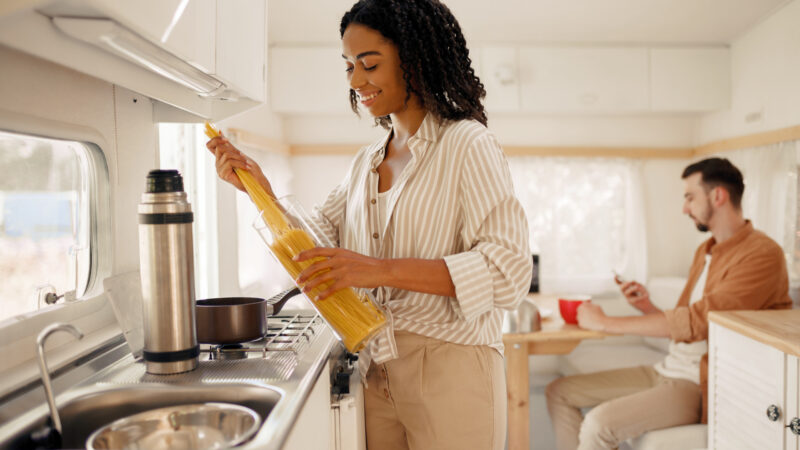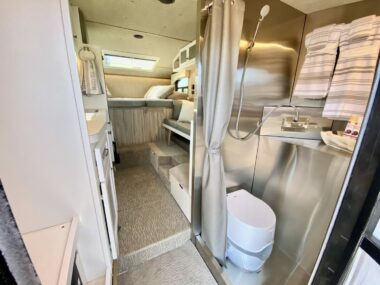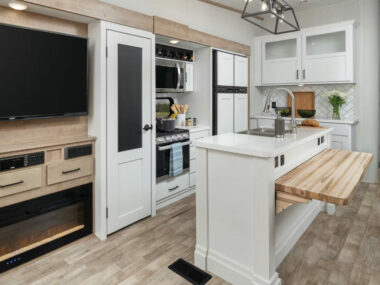Table of Contents Show
Are you new to camping and wondering how to work your propane RV stove? If you haven’t leaped into propane stove cooking in your RV, the stories you’ve heard might intimidate you. You might have your own horror story—one of burnt casserole and scorched muffins.
Your propane RV stove is an appliance that adds value to your camping trip. No need to sit over the fire and wait for your food to cook through.
There’s also no need to prep all your food before the camping trip. We’ll teach you the ins and outs of your propane RV stove and oven and help you gain confidence while using it.
Let’s get cooking!
What Is a Propane RV Stove?
A propane RV stove is a stove inside an RV that runs off propane. It connects through a propane line to the propane tank. It acts similar to a gas stove, but propane fuels it instead.
Since propane has a higher BTU rating, it heats quickly and uses less fuel than natural gas. In that respect, it’s a sleeker option than a natural gas stove.
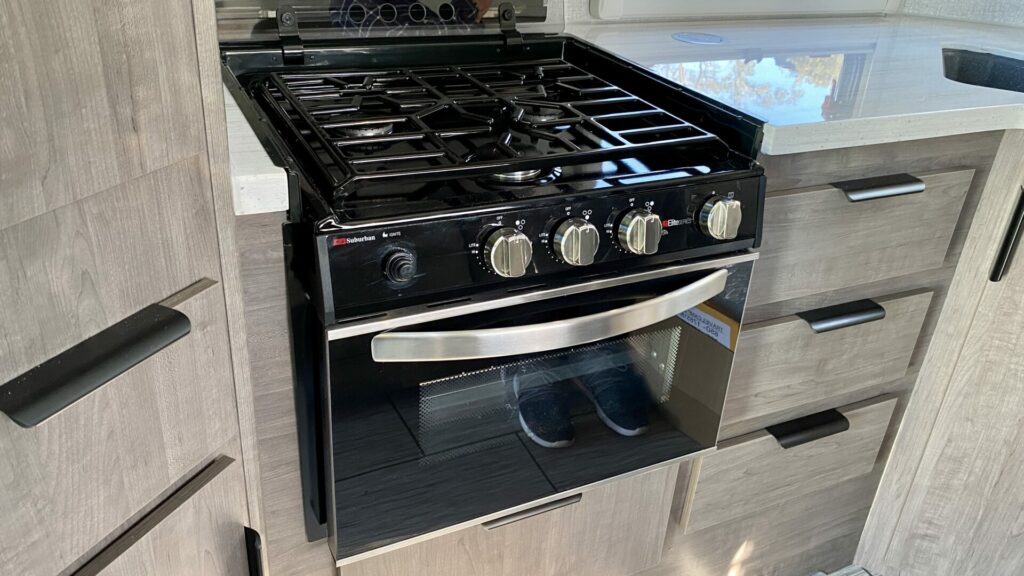
How Does a Propane Stove Work in an RV?
A propane hose connects the propane tank in your RV to your propane stove. You’ll need to have propane in your tank, and you must turn it on to run your stove and oven.
Propane travels through a line to the stove and oven. For the stove, the propane connects to individual burners; there are typically three burners on an RV stove.
You adjust the burner flames to high, medium, and low by adjusting knobs on the front panel, similar to a residential gas stove.
Another line carries the propane into the oven. You then ignite it by lighting a pilot light, and a tube distributes the flame. Then, the flame travels through a heat distribution tray to begin heating the RV oven.
This is the metal tray that sits stationary just above the flame. You adjust the oven’s temperature with a temperature gauge knob on the front panel. There’s a thermostat in the very back of the oven, and it regulates the flame to match the temperature you set.
Why Are Propane RV Stoves Notoriously Hard to Use?
Since the propane stove is inside a moving vehicle, lines and burners are apt to move and might even disconnect. This is the first difference from your household stove.
If you frequently turn off your propane, you’ll need to remember to turn it on. You’ll also need to monitor your propane levels, so you don’t run out of propane when you’re getting ready to bake that casserole.
Propane ovens are challenging appliances for other reasons, too.
First, they can be challenging to light. Typically you have to bend down, stick your head near the oven door, then use a lighter to ignite the pilot light each time you use the oven. The propane oven is small and may not fit your standard baking pans.
Second, propane stoves are notorious for not heating evenly. Expect to burn a few items as you learn the ins and outs of your stove.
Lastly, there’s not a built-in fan to circulate the hot air inside the oven. Know that your oven may not get to the same temperature set on the adjustment knob.
Keep in Mind: Do you need an RV propane detector? The answer is yes, and these are the best!
How Do You Light the Pilot On a Propane Stove?
Your first step is to ensure you turn on your propane. To light the pilot in the propane stove in your RV, visually inspect the range to find the pilot light hole. Often, these are just under the heat distribution plate near the back of the stove.
Then turn your oven knob to the “pilot” marker, push and hold it in, and position a lighter at the pilot light hole inside the back of the oven.
Once you ignite it, it should spark a flame that warms the heat distribution plate. You can then set the correct temperature on your oven knob.
If you’re one of the lucky ones and have a direct spark ignition propane stove, your oven will have an igniter button. This automatically ignites the pilot light. You turn your oven knob to the flame marker, push it in and hold, then click the igniter.
To operate the stove, locate the burner you want to use and set it to the “lite” marker. Then turn the “spark” knob on the stove. Turn the button until it starts clicking, and it will eventually ignite the stove.
When you see the flame, adjust it to create the heat you need.
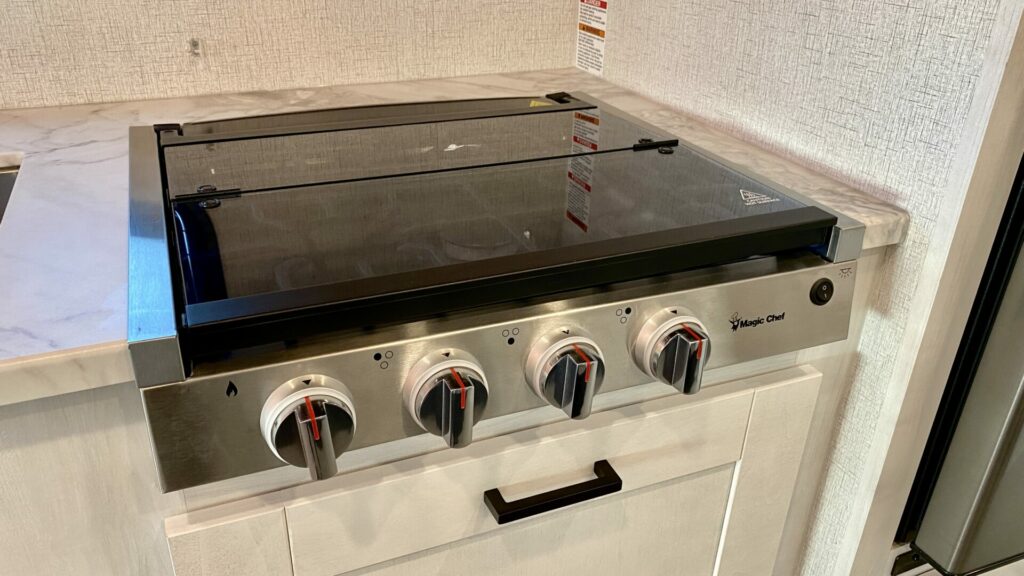
Tips for Using Your Propane RV Stove
We have some ideas to help you bake that perfect apple pie or a delicious loaf of bread in your RV. Below are a few tips and tricks we’ve learned after years of full-time RVing.
Buy an Oven Thermometer
- CLEAR READING: Our oven thermometer is nice for traditional ovens, toaster ovens, or other heat-based food appliances,...
- TEMPERATURE RANGE: this oven thermometer measures oven temperature from 100 to 600°F/ 50 to 300°C to meet different...
Even though your oven comes with a built-in thermostat, we can guarantee it won’t be accurate. After a couple of uses, you’ll see trends in your RV propane stove.
Does it heat too much or not enough? Do you need to adjust the temperature knob by 15 degrees to match the actual temperature?
You won’t always have to rely on the thermometer, but it’ll help you know your oven.
Add a Pizza Stone for Even Cooking
- Size: The pizza stone measures 15" X 12" X 0.6", Golden thickness(15mm), weighs up to 6.7Lbs. Come with a free pizza...
- Material: Made of 100% all-natural FDA-safe Cordierite stone, it is no smell and excellent thermal shock resistance....
Although the heat distribution plate helps distribute the heat evenly in your oven, there’s no fan to circulate the heat. Enter the pizza stone.
Seasoned RVers know to purchase an inexpensive pizza stone, set it on the bottom of your oven, and let it do its job to help distribute the oven heat. It absorbs warmth and helps to dissipate it evenly in the oven.
Keep in Mind: How many of these camping food favorites have you tried? Next time you use your oven, consider trying some of these camping foods!
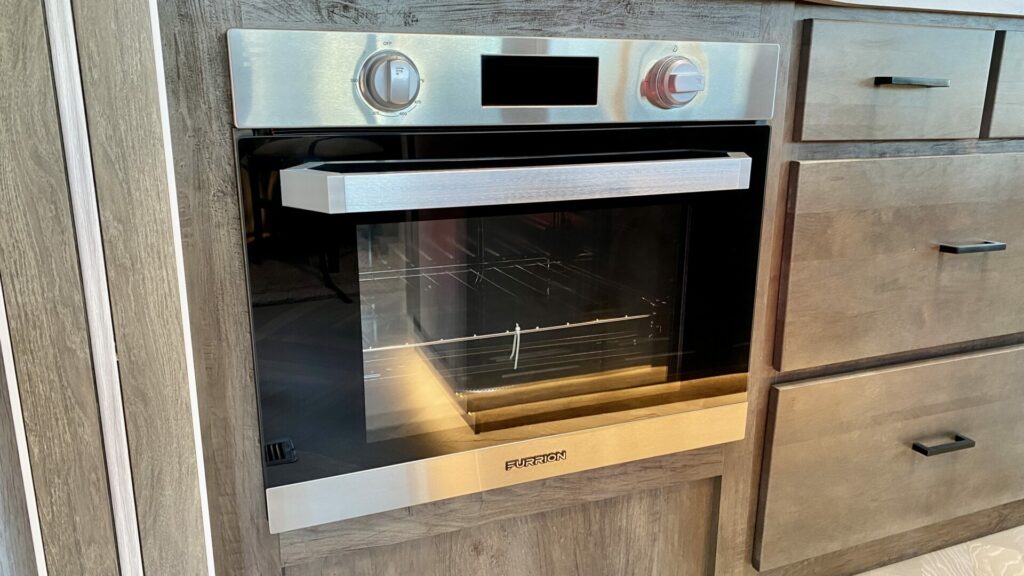
Check Your Food Often
Although the pizza stone and thermometer are an excellent start, we still recommend checking your food. However, don’t check it too often.
Confusing, right? Since the propane stove in your RV is small, each time you open the door, it lets out considerable heat. If yours has a glass front, you’ll likely have a cooking light and won’t need to open the door to peek in.
If you don’t have a window, open the door slightly to check on your food.
Take this opportunity to rotate your dish 180 degrees. The pizza stone helps heat the oven more evenly, but it’s not the same as your residential oven. Rotating food helps get it to your desired temperature.
Also, always have an aluminum foil to cover any crusts or casserole tops that are getting too browned.
Adjust Your Oven Racks Accordingly
Cook food on the slide-out tray, not the heat distribution plate. The heat distribution plate sits atop the flame, which means you’ll have scorched food.
Instead, move the rack to the center, between the heat distribution plate and the top of the oven. Adjust it as needed.
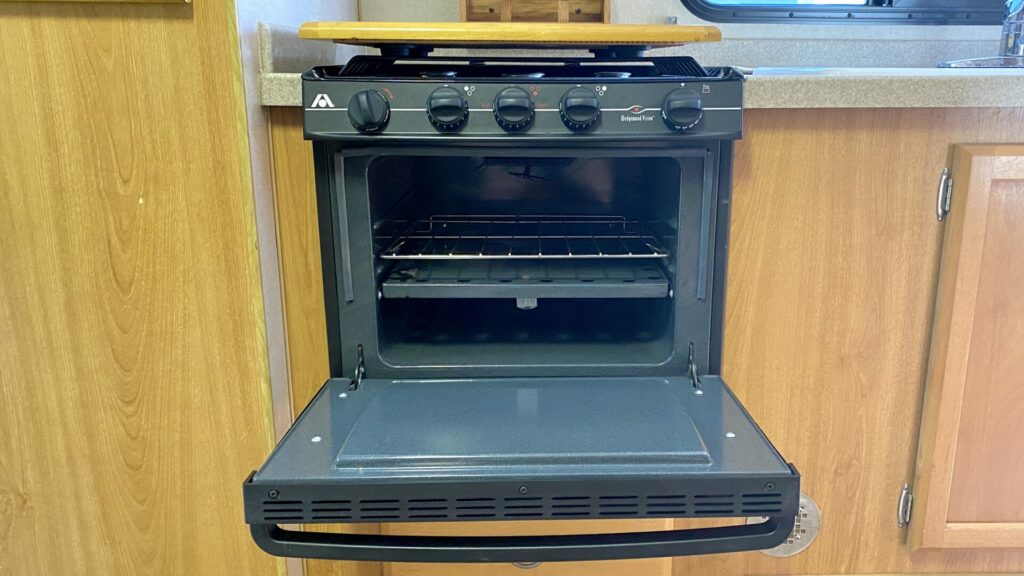
It’s Possible to Cook Great Food With Your Propane RV Stove
We’ve made plenty of tasty food from our propane RV stove and oven, over the years. There’s no need to bake your food in advance or go without an oven while camping.
Instead, get to know your specific range. Then, churn out the yummiest of meals!
Last update on 2025-01-19 / Affiliate links / Images from Amazon Product Advertising API




